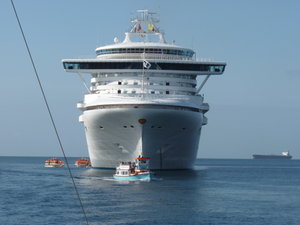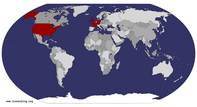Advertisement

 Tendering from Ship
Tendering from Ship
Grand Princess in BackgroundHello from the port of Falmouth in Cornwall England. Today is going to be different for several reasons. First we are going on different tours for the first time in all our cruises, and this is a “tender port” (you get ferried to shore in a small boat instead of docking and going down the gangway). Also a little different today, we had a bright sunny day and reasonably warm weather.
Falmouth claims to be the 3rd largest natural deep water port in the world (behind Sydney and Rio). Because it is so large, the tenders picked up passengers at the side of the ship and took us several miles to the docks in the port, where our buses were waiting. They used both ship’s lifeboats and some local excursion boats to get everyone back and forth fairly efficiently. Luckily the weather was sunny and mild, with smooth seas, so the rides were uneventful and pleasant.
The Cornwall region has the most temperate climate in Great Britain and has become a popular retirement/tourist region. We even drove past a place with a sign saying “Aged Challenged Day Services”, which is their term of an old aged day care center.
There have been both tin mines (mostly closed for the past dozen years) and granite quarries in this region. The quarries are still in use with the current demand for granite counter tops, etc. The primary industry these days is tourism although they are hoping that the recent increases in tin prices might reopen some of those mines. The area is covered with blooming plants from March through November, with the hedgerows along the roads blooming in many different colors. It all looked very neat and clean, and in good condition along the way. Of course the roads are very narrow, especially for tour buses.
David’s tour was supposed to assemble in the theater at 8:30 and Janet’s did not gather until 11:00. So we both got up about 7:00 and had a buffet breakfast and then David went to meet his tour group. His group boarded the tender about 9:00 and he was off to visit St Michel’s Mount. This is a 12th century castle and church built on an island in the English channel, where part of the time you can walk out to the island on a causeway and part of the time you have to

 Pilgrim's Step to Castle
Pilgrim's Step to Castle
1st of 3 different sets of stepsuse small boats (all depends upon whether the tide was in or out). The whole thing is built on a small island and requires a very strenuous climb up 3 different sets of steps/paths. The first are simply large irregular spaced stone blocks that you climb called the “Pilgrim’s Path”. Then there is a steep cobblestone path followed by another climb up more stone blocks (roughly placed like a staircase). This was after walking about 1/2 mile across the cobblestone causeway from shore (we arrived just as the tide was about to uncover the path). This made the “100 steps in Marseilles” look like a cakewalk, although the guide did pause the group’s progress a couple of time to allow stragglers to catch up or catch their breath.
The church started as a Benedictine Monastery but was taken over by Henry VIII when he broke with Rome and changed it to an Anglican Church. It still has Sunday services each week for the locals (hearty souls to climb up their each week). Centuries ago the whole island property was sold and many generations later, the owners still live in it part time. We got to explore all but the
private residence rooms. The whole facility is decorated with antiques and looks just like a medieval castle. Our group did not have access to the extensive gardens today, but it looked like it had almost equally challenging paths if you wanted to explore them. The most remarkable thing the extent to which the sea recedes and advances whether the tide is in or out. The “shuttle boats” are literally beached in the island harbor when the water is out, but the causeway is completely covered when the water is in (wait for these pictures to get posted).
After the tour, David had time in town for some shopping or lunch - he got a “pint and pie” at one of the pubs. Here in Cornwall, their meat pies are called “pasties” and David’s was quite good. On the ride back to the ship, David’s guide (Hugh) and driver (Barry) diverted through the “tin region” and where many ancient “tin engines” had been used to remove the impurities (including arsenic) by melting the ore in furnaces and burning off the impurities through tall chimneys – these are the main things remaining from the early years of mining. Our bus approached

 View of Causeway
View of Causeway
when tide is out at St Michael's MountFalmouth through Penryn (a town about 3 miles up the estuary) and saw that all the boats were sitting flat in the mud because the tide had receded so much. Hugh explained that in early years, barbarians (Vikings, Turks, Pirates, etc) would raid Falmouth so many of the people moved further inland where it was safer because the pirates could not sail up to them and still get away before they were stranded in the mud. David got back to the ship back about 3:00.
Janet’s tour did not leave until 12:30 so she had lunch on the ship and then took the tender to the shore. There she met her guide Malcolm, and Frank the driver. We toured through several small villages related to the tin mining industry. Unfortunately most of the tin now comes from Southeast Asia so most of the homes are holiday homes or for those who have retired. We had a photo stop high in the town of St. Ives which was a spectacular view of the coast, but David had the camera. During the next part of the trip, they explained how Cornish cream is made. It is a very hot process that

 St Michae's Mount
St Michae's Mount
Cornwall England, while tide is outallows the cream to be good to eat for a long period of time. Apparently in Cornwall you put the jelly on the scone and then cover it with the cream while in Devonshire you do the opposite. Since Janet does not eat jelly, it was a moot point. We then stopped at a local hotel and had tea and chance to taste the local product. The scones were delicious and the cream certainly enhanced them. We then made the drive back to the ship on some very narrow and winding roads. The early settlers of the area did not anticipate the busses and cars when they designed the roads. There were a couple of close calls but we made it safely. The guide did point out the area where many of our marines were staged for the D-day invasions. The marines have donated a building near the coast as a thank you gift to the people of Cornwall for their help in that time. The marines come each year and paint the building. We arrived at the dock just as the last tenders were leaving for the ship so we felt pretty rushed but the ship waited for us
and we went straight to dinner.
Dinner this evening was good (as expected). Every cruise they serve Lobster as one choice and Beef Wellington as the alternative. These are Janet’s two favorites and sometimes she has actually had a little of each instead of choosing. Since this cruise she had already had lobster once, this time she just had the beef. David had the lobster though. This was the last time we will probably see one of our couples (Mary & Ray Gillespie) because they have a late tour tomorrow and might not be back in time for dinner with us. The other couple (Andy and Pat) should be there with us tomorrow. Then it was off to the Princess Theater. The show tonight is a violinist who played a variety of kinds of music from around the world. He was very good and it was a very enjoyable show.
They announced some age statistics today. There are 2,496 passengers (which includes some guest entertainers). The average age is 65.7 years old, so we are still in the younger half. There are 4 people under 17, 39 people between 18-29, 51 people between 30-39, 77 people between 40-49, 288 people between 50-59, 1,164 people between 60-69, 744 people between 70-79, 171 people between 80-89, and 6 people over 90. So there are more people over 79 than there are people under 50. Interesting!
Our internet package has been used up so we are using individual minutes the rest of the cruise. Therefore we have not been able to read all our in-coming e-mails. We hope to catch up with the e-mail when we get to Mike & Sue’s on Saturday. Hopefully you have been enjoying each edition of the Garvin escapades as we reported them on our trip. The cruise portion of our vacation has only another couple of days remaining, but we have more exciting activities planned, so keep following the blog postings.
Tomorrow we will be in France, which means we lose still another hour on the clocks. So good night from Falmouth (Cornwall) England and wish us well in dealing with the French.
Advertisement
Tot: 0.109s; Tpl: 0.012s; cc: 14; qc: 51; dbt: 0.0507s; 1; m:domysql w:travelblog (10.17.0.13); sld: 1;
; mem: 1.2mb









